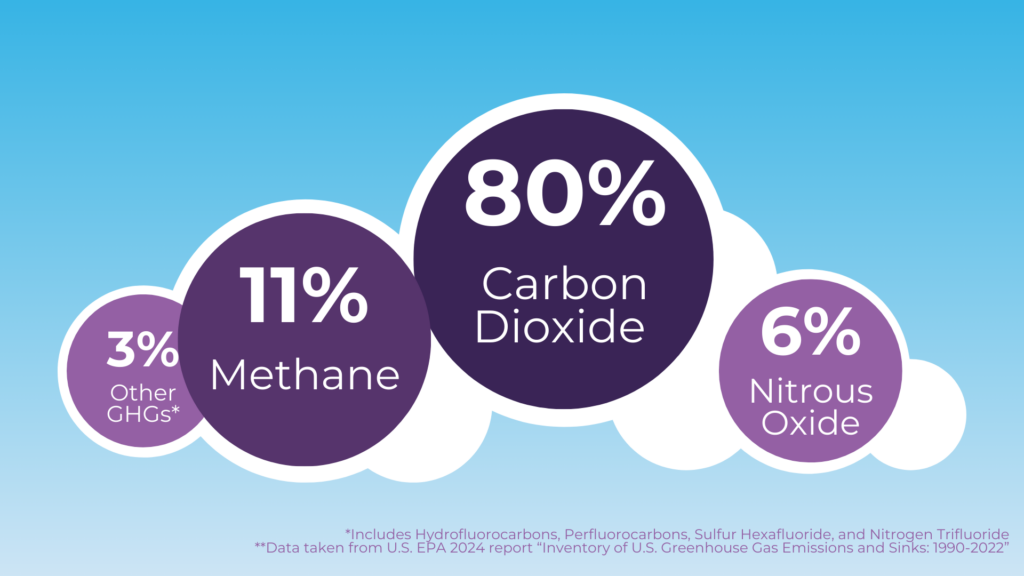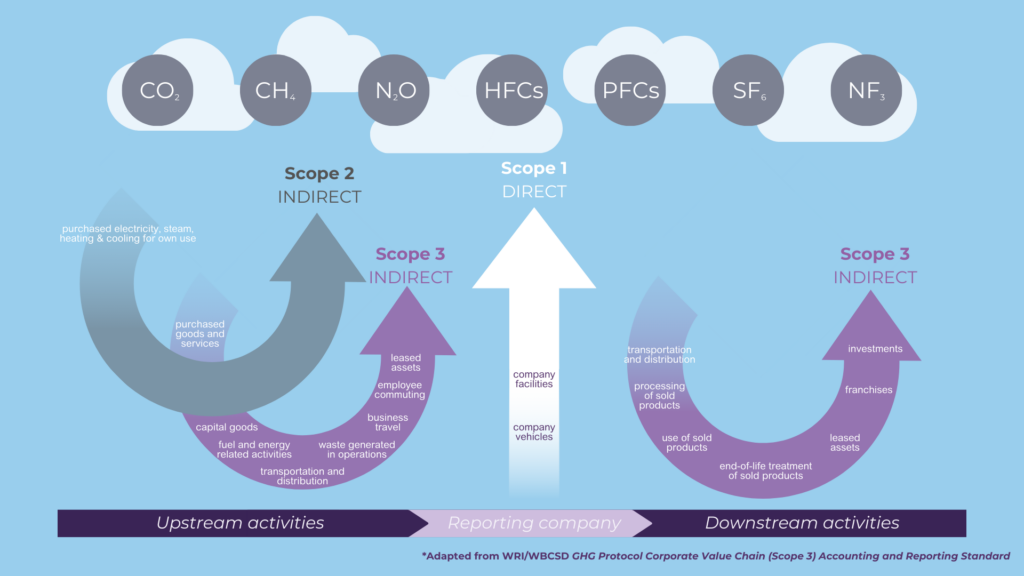Decarbonization might seem overwhelming for companies facing time constraints and limited resources, but it plays an essential role not only in mitigating the effects of climate change, but also in protecting your operations from various business risks. Before taking concrete steps to decarbonize your business, however, it’s critical to first understand the landscape of concepts and terms that surround corporate sustainability efforts.
To help you navigate this complex landscape, we’ve compiled a glossary of key sustainability terms covering a range of decarbonization topics. This guide serves as a practical resource to demystify concepts like carbon footprint, renewable energy, and carbon neutrality, empowering you to take actionable steps toward reducing your environmental impact and positioning your business for a more sustainable future.
Carbon accounting: Tracking and reporting an organization’s carbon emissions and reductions to understand its impact on climate change.
Carbon capture and storage (CCS): Technology that captures CO2 emissions from sources like power plants and stores it underground to prevent it from entering the atmosphere.
Carbon disclosure: The practice of publicly reporting an organization’s carbon emissions and reduction efforts, promoting transparency and accountability.
Carbon footprint: The total amount of greenhouse gases, especially carbon dioxide, that are emitted directly and indirectly by an individual, organization, or product. It’s like a personal or corporate “pollution score.”
Carbon management: Strategies and practices aimed at measuring, reducing, and offsetting carbon emissions within an organization.
Carbon neutrality: A state of operations where the carbon emitted is equal to the amount of carbon removed, often through offsets or renewable energy.
Carbon offset: A way to compensate for your carbon emissions by investing in projects that reduce or remove an equivalent amount of CO2 from the atmosphere, like tree planting or renewable energy projects.
Carbon offset project: Initiatives that generate carbon credits by reducing or removing emissions, which can be purchased by individuals or companies.

Curious about carbon offsets?
Check out our article breaking down how carbon offsets work and what that means for your business.
Read the full articleCarbon pricing: A method to make polluters pay for the carbon they emit, encouraging them to reduce emissions. It can be in the form of a carbon tax or cap-and-trade systems. .
Carbon reduction target: A specific goal set by an organization to reduce its carbon emissions by a certain percentage within a defined timeframe.
Carbon reporting: The process of documenting and sharing data on an organization’s carbon emissions and reduction efforts.
Carbon sequestration: The long-term storage of carbon dioxide, often through natural processes like forest growth or technological methods.
Carbon stewardship: The responsibility of individuals and organizations to manage and reduce their carbon emissions and environmental impact.
Carbon tax: A tax imposed on companies based on the amount of carbon dioxide they emit, aimed at reducing greenhouse gas emissions.
Carbon trading: The buying and selling of carbon emission allowances as part of a cap-and-trade system to encourage emission reductions
Decarbonization: The process of reducing carbon emissions, often through transitioning to renewable energy and improving energy efficiency.

Need a refresher on decarbonization?
Our comprehensive guide breaks down everything you need to know about reducing your business’ carbon footprint.
Read the full articleDistributed energy resources: Small-scale energy generation and storage technologies located close to where the energy is used, like rooftop solar panels.
Energy audit: A thorough assessment of how energy is used in a building or organization, aimed at identifying ways to improve efficiency and reduce costs.
Energy benchmarking: Comparing energy performance against standards or similar organizations to identify areas for improvement.
Energy conservation: Efforts to reduce energy consumption through behavioral changes and better practices, like turning off lights when not needed.
Energy efficiency: This refers to using less energy to provide the same service. For example, LED bulbs are more energy-efficient than traditional incandescent bulbs.
Energy intensity: A measure of the amount of energy consumed per unit of output, like energy used per product manufactured, reflecting efficiency.
Energy management software: Digital tools that help organizations track and manage their energy use, often providing insights for efficiency improvements.
Energy management system: A framework or software that helps organizations monitor, control, and optimize their energy use.
Energy modeling: The process of simulating energy use in buildings or systems to predict consumption and identify efficiency opportunities.
Energy monitoring: Continuously tracking energy consumption to identify patterns and opportunities for savings.
Energy recovery: The process of capturing and reusing waste energy, such as heat generated by industrial processes.
Energy transition: The global shift from fossil fuel-based energy systems to renewable and sustainable energy sources
Emission factors: Values that estimate the amount of greenhouse gas emissions produced per unit of activity, like tons of CO2 per megawatt-hour of electricity generated.
Emissions trading: A market-based approach where companies can buy and sell allowances to emit a certain amount of greenhouse gases, incentivizing reductions.
Green building: Structures designed to be environmentally responsible and resource-efficient throughout their lifecycle, often featuring energy-efficient systems and sustainable materials. Common green building certifications include LEED, BREEAM, and WELL.
Greenhouse gas emissions: These are gases that trap heat in the atmosphere, contributing to climate change. Common ones include carbon dioxide (CO2), methane (CH4), and nitrous oxide (N2O).

Grid decarbonization: Transitioning the energy grid away from fossil fuels to low-carbon and renewable energy sources.
Life cycle assessment (LCA): A technique to assess the environmental impact of a product from raw material extraction to disposal, helping identify areas for improvement.
Low-carbon energy: Energy sources that produce little to no carbon emissions during generation, such as solar, wind, and hydro.
Net zero: Achieving a balance between the amount of greenhouse gases emitted and the amount removed from the atmosphere. The goal is to effectively have no net increase in emissions.

Want to know more about Net-Zero?
Learn more in our article dedicated to Net Zero; what does it mean, and why is it worth it?
Read the full articleOffsetting: The act of compensating for carbon emissions by investing in projects that reduce or remove CO2 from the atmosphere.
Power purchase agreement (PPA): A contract between a buyer and a seller of energy, typically involving renewable sources, outlining the terms of energy delivery and pricing.
Renewable energy: Energy that comes from natural sources that can be replenished, like solar, wind, and hydro power. It’s cleaner and more sustainable than fossil fuels.
Renewable energy certificates (RECs): These certificates prove that a certain amount of renewable energy has been generated and can be traded to support renewable energy production. Also known as Energy Attribute Certificates (EACs), Guarantees of Origin (GOs), Tradable instruments for global renewables (TIGRs), and more.
Renewable portfolio standard: A regulation requiring utilities to obtain a certain percentage of their energy from renewable sources.
Scope 1 emissions: These are direct emissions from owned or controlled sources, like a company’s vehicles or facilities.
Scope 2 emissions: These are indirect emissions from the generation of purchased energy, like electricity used by a company but produced elsewhere.
Scope 3 emissions: These are all other indirect emissions that occur in a company’s value chain, including those from suppliers and customers.

Smart grid: An upgraded electrical grid that uses digital technology to monitor and manage electricity flow, improving efficiency and reliability.
Sustainable energy: Energy that meets the needs of the present without compromising the ability of future generations to meet their own needs, often focusing on renewables.
Now that you know your sustainability terms… what next?
Zeigo can help you take your newfound knowledge and implement it into your business’ operations. Check out our comprehensive decarbonization guide to learn more!
